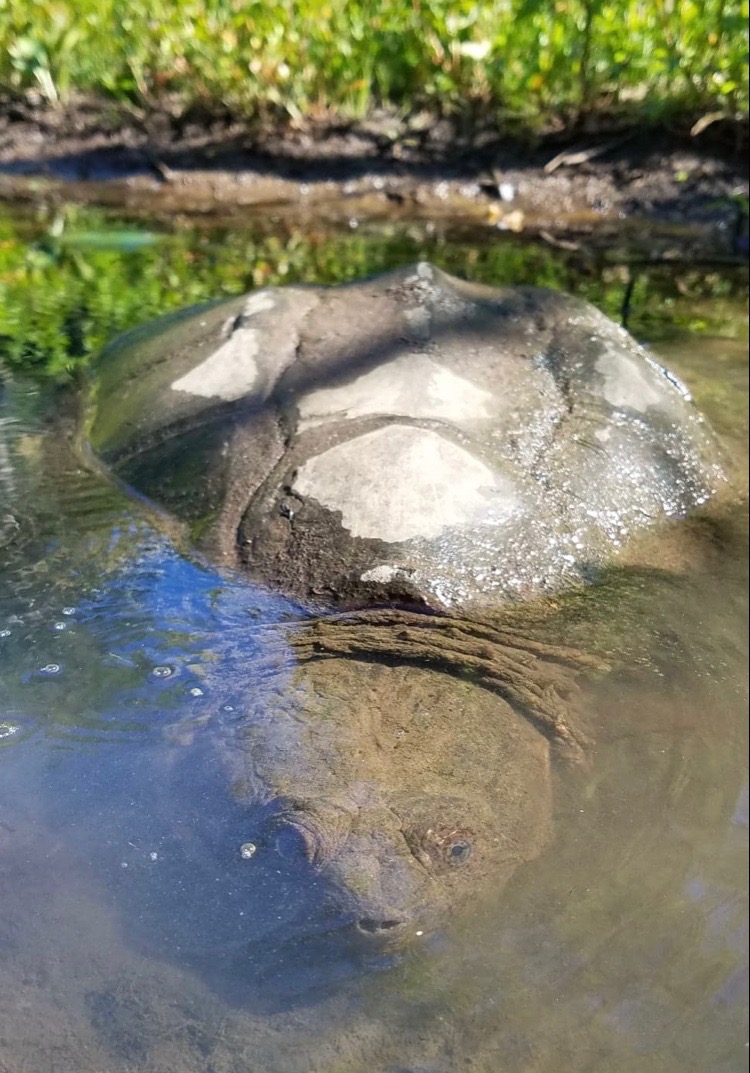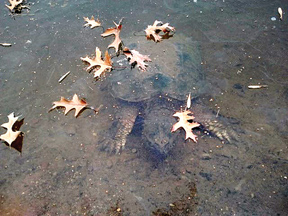Snapping turtles hibernate by burying themselves in mud underwater to survive cold temperatures. Snapping turtles, like many reptiles, undergo a process called hibernation to survive harsh winter conditions.
During hibernation, they slow down their metabolic processes and bury themselves in mud at the bottom of ponds or lakes. This allows them to conserve energy and remain dormant until temperatures rise again. Hibernation is crucial for snapping turtles to survive the cold and scarcity of food during winter months.
Understanding how snapping turtles hibernate sheds light on their remarkable ability to adapt to changing environmental conditions. Let’s delve deeper into the fascinating process of snapping turtle hibernation and explore how these resilient creatures navigate through challenging winter seasons.
Habitat Preparation
When it comes to snapping turtles hibernating, habitat preparation plays a crucial role in ensuring their survival during the winter months. The process of choosing a hibernation site and burrowing into mud is essential for these fascinating creatures to endure the cold season.
Choosing Hibernation Site
Snapping turtles carefully select their hibernation sites to ensure they are well-protected from harsh weather conditions. They seek out areas with deep, soft mud that provides insulation and protection from freezing temperatures. Typically, they choose the muddy bottoms of ponds, streams, or shallow lakes where they can burrow and remain undisturbed until spring.
Burrowing Into Mud
As the temperatures drop, snapping turtles begin the process of burrowing into the mud to prepare for hibernation. They use their powerful limbs and sharp claws to dig deep into the soft mud, creating a cozy chamber where they will spend the winter months. This burrowing not only provides insulation but also shields them from potential predators.

Credit: sigreenbelt.org
Physiological Changes
When it comes to hibernation, snapping turtles undergo fascinating physiological changes to survive the harsh winter months. These changes allow them to adapt to the cold temperatures and limited resources, ensuring their survival until warmer conditions return. Let’s explore the specific physiological changes that snapping turtles undergo during hibernation.
Lowered Metabolism
During hibernation, snapping turtles experience a significant decrease in their metabolic rate. This lowered metabolism helps them conserve energy and survive on minimal resources. By reducing their metabolic activity, snapping turtles can endure long periods of dormancy without the need for regular feeding or active movement.
Breathing Adaptations
Snapping turtles also exhibit remarkable breathing adaptations during hibernation. While submerged in the icy waters, they can extract oxygen from the surrounding environment through specialized skin and cloacal membranes. This unique adaptation allows them to maintain sufficient oxygen levels without the need for regular surfacing, ensuring their survival in oxygen-deprived conditions.
Behavioral Adaptations
Snapping turtles are fascinating creatures that live in freshwater environments across North America. During the winter months, they undergo a process called hibernation, which allows them to survive in cold temperatures when food and resources are scarce. This process involves several behavioral adaptations that help the turtles conserve energy and stay safe during the winter months.
Reduced Activity
One of the primary behavioral adaptations that snapping turtles undergo during hibernation is reduced activity. As the temperature drops, the turtles become less active and begin to slow down. They may spend much of their time resting on the bottom of their aquatic habitat, conserving energy and avoiding unnecessary movement. This reduced activity allows them to conserve energy and survive through the winter months.
Conserving Energy
Another important behavioral adaptation of snapping turtles during hibernation is energy conservation. When the turtles slow down, their metabolism also slows down, allowing them to conserve energy and reduce their food requirements. In addition, the turtles may bury themselves in the mud at the bottom of their habitat, creating a protective layer that helps keep them warm and conserve energy. This energy conservation is crucial for the turtles to survive through the winter months when food and resources are scarce.
Conclusion
Snapping turtles are remarkable creatures that have adapted to survive in harsh environments. During the winter months, they undergo a process of hibernation that involves several behavioral adaptations, including reduced activity and energy conservation. These adaptations allow them to conserve energy, stay safe, and survive through the winter months, ensuring their continued survival for generations to come.
Survival Strategies
Resisting Freezing
Snapping turtles have a remarkable ability to survive harsh winters by hibernating. When the temperature drops, these cold-blooded reptiles dig into the mud at the bottom of ponds or lakes, where they remain dormant. The turtles’ metabolism slows down significantly, allowing them to conserve energy and endure the freezing temperatures.
Avoiding Predators
During hibernation, snapping turtles employ various strategies to avoid becoming prey. They bury themselves deep in the mud, making it difficult for predators to detect and reach them. Additionally, their tough, protective shells provide a crucial defense against potential threats, safeguarding them from harm while they are in a vulnerable state.
Length Of Hibernation
Hibernation is an essential survival strategy for snapping turtles during the harsh winter months. Understanding the length of their hibernation period can provide valuable insight into the behavior and adaptation of these fascinating creatures.
Duration Variations
The length of hibernation for snapping turtles can vary depending on various factors such as geographic location, environmental conditions, and the individual turtle’s health and age. In general, snapping turtles hibernate for an average of 4 to 5 months during the winter, but this duration can fluctuate significantly.
Trigger For Emergence
As the temperatures begin to rise and the winter season comes to an end, snapping turtles are triggered to emerge from hibernation. This emergence is primarily influenced by the warming of their hibernation site and the availability of suitable food sources.

Credit: www.reddit.com
Impact Of Climate Change
Climate change has significant impacts on various animal species, including snapping turtles. These turtles have a unique way of surviving harsh weather conditions by hibernating. Hibernation is a period of inactivity where the body temperature drops, and metabolic processes slow down. However, with the changing climate, snapping turtles face significant challenges that affect their hibernation patterns.
Effect On Hibernation Patterns
The changing weather patterns have a direct impact on snapping turtles’ hibernation patterns. As the winters become milder, turtles may not hibernate for long periods, leading to severe health issues. On the other hand, sudden temperature drops can cause turtles to enter hibernation too early, leading to a lack of food and possible death. The unstable weather patterns affect the turtles’ ability to predict the start and end of the hibernation period, leading to severe consequences.
Adaptation Challenges
Snapping turtles face several adaptation challenges due to climate change. The turtles have evolved to hibernate in specific conditions, and sudden changes in temperature can lead to significant stress. The turtles may not have enough time to prepare for hibernation, and the sudden onset of winter can lead to a lack of food and shelter. The changes in the hibernation patterns can also affect the breeding and migration patterns of snapping turtles, leading to a decline in their population.
Conclusion
In conclusion, climate change has significant impacts on snapping turtles’ hibernation patterns. The changing weather patterns affect the turtles’ ability to predict the start and end of the hibernation period, leading to severe consequences. Furthermore, the turtles face several adaptation challenges due to climate change, which affects their breeding and migration patterns, leading to a decline in their population. It is crucial to take action and mitigate the effects of climate change to ensure the survival of these unique creatures.
Conservation Concerns
Human Disturbances
Human disturbances such as habitat destruction, pollution, and road mortality pose significant threats to snapping turtles and their hibernation sites. Habitat destruction due to urbanization and agricultural expansion can lead to the loss of suitable hibernation areas for snapping turtles. Pollution, especially water pollution, can negatively impact the quality of hibernation sites, affecting the health and survival of these turtles. Road mortality is another concern as turtles often get struck by vehicles while migrating to and from their hibernation sites.
Protection Efforts
Protection efforts play a vital role in ensuring the survival of snapping turtles and their hibernation habitats. Conservation organizations and wildlife authorities work to protect and preserve the natural habitats of snapping turtles. Educational programs aimed at raising awareness about the importance of conserving snapping turtle habitats can help reduce human disturbances. Regulatory measures such as creating wildlife corridors and implementing speed limits near turtle crossing areas can mitigate road mortality. Habitat restoration projects can also contribute to providing suitable hibernation sites for snapping turtles.

Credit: www.northcountrypublicradio.org
Conclusion
As snapping turtles prepare for hibernation, they seek out watery environments to survive winter. Their remarkable ability to slow down bodily functions helps them conserve energy during this dormant period. Understanding how snapping turtles hibernate sheds light on their fascinating survival strategies in the wild.






Leave a Reply